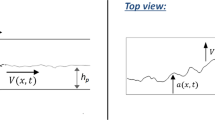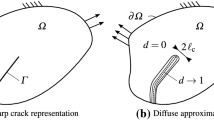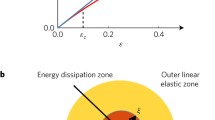Abstract
We address analytically and numerically the problem of crack path prediction in the model system of a crack propagating under thermal loading. We show that one can explain the instability from a straight to a wavy crack propagation by using only the principle of local symmetry and the Griffith criterion. We then argue that the calculations of the stress intensity factors can be combined with the standard crack propagation criteria to obtain the evolution equation for the crack tip within any loading configuration. The theoretical results of the thermal crack problem agree with the numerical simulations we performed using a phase field model. Moreover, it turns out that the phase-field model allows to clarify the nature of the transition between straight and oscillatory cracks which is shown to be supercritical.
Similar content being viewed by others
References
Acerbi E, Braides A (1999) Approximation of free-discontinuity problems by elliptic functionals via Γ-convergence. Asymptot Anal 21: 317–329
Adda-Bedia M, Pomeau Y (1995) Crack instabilties of a heated glass strip. Phys Rev E 52: 4105–4113
Adda-Bedia M, Arias R, Ben Amar M, Lund F (1999) Generalized Griffith criterion for dynamic fracture and the stability of crack motion at high velocities. Phys Rev E 60: 2366–2376
Ambrosio L, Tortorelli VM (1990) Approximation of functionals depending on jumps by elliptic functionals via Γ-convergence. Comm Pure Appl Math 43: 999–1036
Ambrosio L, Tortorelli VM (1992) On the approximation of free discontinuity problems. Boll Un Mat Ital B 6: 105–123
Amestoy M, Leblond JB (1992) Crack paths in plane situations–II. Detailed form of the expansion of the stress instensity factors. Int J Solids Struct 29: 465–501
Aranson IS, Kalatsky VA, Vonokur VM (2000) Continuum field description of crack propagation. Phys Rev Lett 85: 118–121
Audoly B, Reis PM, Roman B (2005) Cracks in brittle elastic plates: when geometry rules fracture paths. Phys Rev Lett 95: 025502
Bahr HA, Gerbatsch A, Bahr U, Weiss HJ (1995) Oscillatory instability in thermal cracking: a first-order phase-transition phenomenon. Phys Rev E 52: 240–243
Barenblatt G., Cherepanov G (1961) On brittle cracks under longitudinal shear. PMM 25: 1110–1119
Bilby BA, Cardew GE (1975) The crack with a kinked tip. Int J Fract 11: 708–712
Bouchbinder E, Hentschel HGE, Procaccia I (2003) Dynamical instabilities of quasistatic crack propagation under thermal stress. Phys Rev E 68: 036601
Braides A (1998) Approximation of free-discontinuity problems. Springer-Verlag, Berlin
Broberg KB (1999) Cracks and fracture. Academic Press, London
Caginalp G, Fife P (1986) Phase field methods for interfacial boundaries. Phys Rev B 33: 7792–7794
Collins JB, Levine H (1986) Diffuse interface model of diffusion-limited cristal growth. Phys Rev B 31: 6119–6122
Cotterell B, Rice JR (1980) Slightly curved or kinked cracks. Int J Fract 16: 155–169
Deegan RD, Chheda S, Patel L, Marder M, Swinney HL, Kim J, Lozanne A (2003) Wavy and rough cracks in silicon. Phys Rev E 67: 066209
Eastgate LO, Sethna JP, Rauscher M, Cretegny T, Chen CS, Myers CR (2002) Fracture in mode I using a conserved phase-field model. Phys Rev E 65: 036117
Erdogan G, Sih GC (1963) On the crack extension in plates under plane loading and transverse shear. J Basic Eng 85: 519–527
Etchebarria B, Folch R, Karma A, Plapp P (2004) Quantitative phase-field model of alloy solidification. Phys Rev E 70: 061604
Fineberg J, Marder M (1999) Instability in dynamic fracture. Phys Rep 313: 2–108
Folch R, Casademunt J, Hernandez-Machado A (2000) Viscous fingering in liquid crystals: anisotropy and morphological transitions. Phys Rev E 61: 6632–6638
Freund LB (1990) Dynamic Fracture Mechanics. Cambridge University Press, Cambridge
Ghatak A, Mahadevan L (2003) Crack street: the cycloidal wake of a cylinder ripping through a thin solid sheet. Phys Rev Lett 91: 215507
Gol’dstein RV, Salganik RL (1974) Brittle fracture of solids with arbitrary cracks. Int J Fract 10: 507–523
Griffith AA (1920) The phenomenon of rupture and flow in solid. Phil Trans R Soc Lond Ser A 221: 163–198
Hakim V, Karma A (2005) Crack path prediction in anisotropic brittle materials. Phys Rev Lett 95: 235501
Hakim V, Karma A (2009) Laws of crack motion and phase-field models of fracture. J Mech Phys Solids 57: 342–368
Henry H, Levine H (2004) Dynamic instabilities of fracture under biaxial strain using a phase field model. Phys Rev Lett 93: 105504
Henry H (2008) Study of the branching instability using a phase field model of inplane crack propagation. EPL 83: 16004
Hodgdon JA, Sethna JP (1993) Derivation of a general three-dimensional crack-propagation law–A generalization of the principle of local symmetry. Phys Rev B 47: 4831–4840
Irwin GR (1957) Analysis of stresses and strains near the end of a crack traversing a plate. J Appl Mech 24: 361–364
Karma A, Rappel WJ (1998) Quantitative phase-field modeling of dendritic growth in two and three dimensions. Phys Rev E 57: 4323–4349
Katzav E, Adda-Bedia M, Derrida B (2007a) Fracture surfaces of heterogeneous materials: a 2D solvable model. EPL 78: 46006
Katzav E, Adda-Bedia M, Arias R (2007b) Theory of dynamic crack branching in brittle materials. Int J Fract 143: 245–271
Karma A, Kessler DA, Levine H (2001) Phase-field model of mode III dynamic fracture. Phys Rev Lett 87: 045501
Karma A, Lobkovsky AE (2004) Unsteady crack motion and branching in a phase field model of brittle fracture. Phys Rev Lett 92: 245510
Kobayashia R, Warren JA (2005) Modeling the formation and dynamics of polycrystals in 3D. Physica A 356: 127–132
Leblond JB (1989) Crack paths in plane situations— I. General form of the expansion of the stress instensity factors. Int J Solids Struct 25: 1311–1325
Leblond JB (2003) Mécanique de la rupture fragile et ductile. Hermes Science Publications, Paris
Marconi VI, Jagla EA (2005) Diffuse interface approach to brittle fracture. Phys Rev E 71: 036110
Marder M (1994) Instability of a crack in a heated strip. Phys Rev E 49: 51–54
Pham VB, Bahr HA, Bahr U, Balke H, Weiss HJ (2008) Global bifurcation criterion for oscillatory crack path instability. Phys Rev E 77: 066114
Press WH, Teukolsky SA, Vetterling WT, Flannery BP (2007) Numerical recipes. Cambridge University Press, Cambridge
Ronsin O, Heslot F, Perrin B (1995) Experimental study of quasistatic brittle crack propagation. Phys Rev Lett 75: 2352–2355
Ronsin O (1996) Etude expérimentale de la propagation de fractures dirigées en milieu fragile. PhD thesis, Université Paris VI
Ronsin O, Perrin B (1998) Dynamics of quasistatic directional crack growth. Phys Rev E 58: 7878–7886
Sakaue K, Yoneyama S, Kikuta H, Takashi M (2008) Evaluating crack tip stress field in a thin glass plate under thermal load. Eng Fract Mech 75: 1015–1026
Sasa S, Sekimoto K, Nakanishi H (1994) Oscillatory instability of crack propagations in quasi-static fracture. Phys Rev E 50: 1733–1736
Sendova M, Willis K (2003) Spiral and curved periodic crack patterns in sol-gel films. Appl Phys A 76: 957–959
Yang B, Ravi-Chandar K (2001) Crack path instabilities in a quenched glass plate. J Mech Phys Solids 49: 91–130
Yoneyama S, Sakaue K, Kikuta H, Takashi M (2006) Instantaneous phase-stepping photoelasticity for the study of crack growth behaviour in a quenched thin glass plate. Meas Sci Technol 17: 3309–3316
Yoneyama S, Sakaue K, Kikuta H, Takashi M (2008) Observation of stress field around an oscillating crack tip in a quenched thin glass plate. Exp Mech 48: 367–374
Yuse A, Sano M (1993) Transition between crack patterns in quenched glass plates. Nature 362: 329–331
Yuse A, Sano M (1997) Instabilities of quasi-static crack patterns in quenched glass plates. Physica D 108: 365–378
Author information
Authors and Affiliations
Corresponding author
Rights and permissions
About this article
Cite this article
Corson, F., Adda-Bedia, M., Henry, H. et al. Thermal fracture as a framework for quasi-static crack propagation. Int J Fract 158, 1–14 (2009). https://doi.org/10.1007/s10704-009-9361-4
Received:
Accepted:
Published:
Issue Date:
DOI: https://doi.org/10.1007/s10704-009-9361-4




